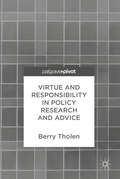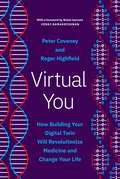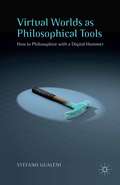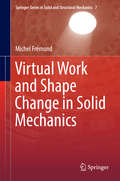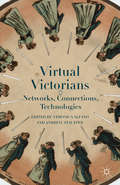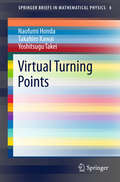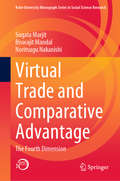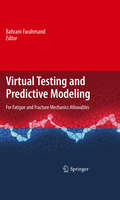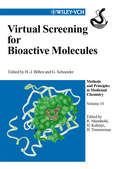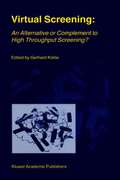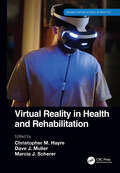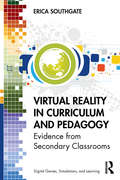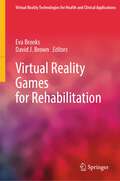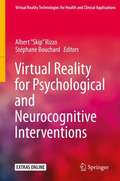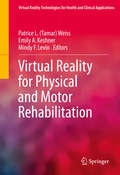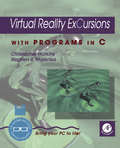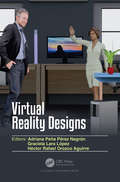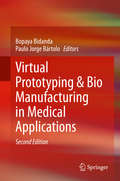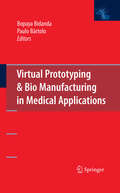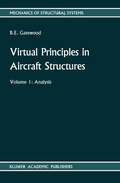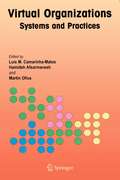- Table View
- List View
Virtue and Responsibility in Policy Research and Advice
by Berry TholenThis book argues that ethical judgment by individual scientific policy advisors is more important than is often acknowledged. While many scientific policy advisors routinely present themselves as neutral or value free scientists, here is demonstrated that the ideal of scientific integrity as neutrality is misguided and that an alternative understanding is demanded. The book provides an overview of the type of social and political value decisions that have to be made in all phases of research and advice. It moves on to examine proposed procedures or guidelines for scientists and critically assesses plans for the democratization of decision making in science and scientific advice. The book offers a reflection on the practice of scientific advice that will appeal to practitioners and scholars of Public Administration, Public Management and Policy Analysis.
Virtual You: How Building Your Digital Twin Will Revolutionize Medicine and Change Your Life
by Peter Coveney Roger HighfieldThe visionary science behind the digital human twins that will enhance our health and our futureVirtual You is a panoramic account of efforts by scientists around the world to build digital twins of human beings, from cells and tissues to organs and whole bodies. These virtual copies will usher in a new era of personalized medicine, one in which your digital twin can help predict your risk of disease, participate in virtual drug trials, shed light on the diet and lifestyle changes that are best for you, and help identify therapies to enhance your well-being and extend your lifespan—but thorny challenges remain.In this deeply illuminating book, Peter Coveney and Roger Highfield reveal what it will take to build a virtual, functional copy of a person in five steps. Along the way, they take you on a fantastic voyage through the complexity of the human body, describing the latest scientific and technological advances—from multiscale modeling to extraordinary new forms of computing—that will make “virtual you” a reality, while also considering the ethical questions inherent to realizing truly predictive medicine.With an incisive foreword by Nobel Prize–winning biologist Venki Ramakrishnan, Virtual You is science at its most astounding, showing how our virtual twins and even whole populations of virtual humans promise to transform our health and our lives in the coming decades.
Virtual You: How Building Your Digital Twin Will Revolutionize Medicine and Change Your Life
by Peter Coveney Roger HighfieldThe visionary science behind the digital human twins that will enhance our health and our futureVirtual You is a panoramic account of efforts by scientists around the world to build digital twins of human beings, from cells and tissues to organs and whole bodies. These virtual copies will usher in a new era of personalized medicine, one in which your digital twin can help predict your risk of disease, participate in virtual drug trials, shed light on the diet and lifestyle changes that are best for you, and help identify therapies to enhance your well-being and extend your lifespan—but thorny challenges remain.In this deeply illuminating book, Peter Coveney and Roger Highfield reveal what it will take to build a virtual, functional copy of a person in five steps. Along the way, they take you on a fantastic voyage through the complexity of the human body, describing the latest scientific and technological advances—from multiscale modeling to extraordinary new forms of computing—that will make “virtual you” a reality, while also considering the ethical questions inherent to realizing truly predictive medicine.With an incisive foreword by Nobel Prize–winning biologist Venki Ramakrishnan, Virtual You is science at its most astounding, showing how our virtual twins and even whole populations of virtual humans promise to transform our health and our lives in the coming decades.
Virtual Worlds as Philosophical Tools: How to Philosophize with a Digital Hammer
by Stefano GualeniWho are we in simulated worlds? Will experiencing worlds that are not 'actual' change our ways of structuring thought? Can virtual worlds open up new possibilities to philosophize? Virtual Worlds as Philosophical Tools tries to answer these questions from a perspective that combines philosophy of technology with videogame design.
Virtual Work and Shape Change in Solid Mechanics (Springer Series in Solid and Structural Mechanics #7)
by Michel FrémondThis book provides novel insights into two fundamental subjects in solid mechanics: virtual work and shape change. The author explains how the principle of virtual work represents a tool for analysis of the mechanical effects of the evolution of the shape of a system, how it can be applied to observations and experiments, and how it may be adapted to produce predictive theories of numerous phenomena. The book is divided into three parts. The first relates the principle of virtual work to what we observe with our eyes, the second demonstrates its flexibility on the basis of many examples, and the third applies the principle to predict the motion of solids with large deformations. Examples of both usual and unusual shape changes are presented, and equations of motion, some of which are entirely new, are derived for smooth and non-smooth motions associated with, for instance, systems of disks, systems of balls, classical and non-classical small deformation theories, systems involving volume and surface damage, systems with interactions at a distance (e.g., solids reinforced by fibers), systems involving porosity, collisions, and fracturing of solids.
Virtual Victorians: Networks, Connections, Technologies
by Andrew Stauffer Veronica AlfanoExploring how scholars use digital resources to reconstruct the 19th century, this volume probes key issues in the intersection of digital humanities and history. Part I examines the potential of online research tools for literary scholarship while Part II outlines a prehistory of digital virtuality by exploring specific Victorian cultural forms.
Virtual Turning Points (SpringerBriefs in Mathematical Physics #4)
by Naofumi Honda Takahiro Kawai Yoshitsugu TakeiThe discovery of a virtual turning point truly is a breakthrough in WKB analysis of higher order differential equations. This monograph expounds the core part of its theory together with its application to the analysis of higher order Painlevé equations of the Noumi–Yamada type and to the analysis of non-adiabatic transition probability problems in three levels.As M.V. Fedoryuk once lamented, global asymptotic analysis of higher order differential equations had been thought to be impossible to construct. In 1982, however, H.L. Berk, W.M. Nevins, and K.V. Roberts published a remarkable paper in the Journal of Mathematical Physics indicating that the traditional Stokes geometry cannot globally describe the Stokes phenomena of solutions of higher order equations; a new Stokes curve is necessary.
Virtual Trade and Comparative Advantage: The Fourth Dimension (Kobe University Monograph Series in Social Science Research)
by Sugata Marjit Biswajit Mandal Noritsugu NakanishiThe main purpose of this book is to expose economics graduate students and researchers to the most significant development in international trade that has taken place in the recent past. Service transactions now make up a sizeable portion of global trade. Trade in both final and intermediate inputs is done virtually through information and communication networks, raising afresh the question of the basis of trade and calling for in-depth investigation. This book succinctly comes up with a relatively new explanation for the basis of trade, thus it adds a new dimension to three existing building blocks: technology, endowment, and returns to scale. Against a backdrop of standard Ricardian and Heckscher–Ohlin competitive models of trade, the chapters of this book nicely introduce the issue of communication cost and the difference in time zones between two trading nations. Then follow many intricate phenomena such as informality, skill formation, growth, wage inequality, and decisions regarding foreign direct investment (FDI). However, imperfectly competitive models are not dealt with in great detail as they deserve more space than can be allotted to them here. Given the nonexistence of any research-oriented in-depth analyses of competitive trade models with time-zone differences, this book is a valuable addition to the resources available to researchers and policymakers interested in deciphering recent developments in global trade patterns and the subsequent welfare effect.
Virtual Testing and Predictive Modeling: For Fatigue and Fracture Mechanics Allowables
by Bahram FarahmandThematerialsusedinmanufacturingtheaerospace,aircraft,automobile,andnuclear parts have inherent aws that may grow under uctuating load environments during the operational phase of the structural hardware. The design philosophy, material selection, analysis approach, testing, quality control, inspection, and manufacturing are key elements that can contribute to failure prevention and assure a trouble-free structure. To have a robust structure, it must be designed to withstand the envir- mental load throughout its service life, even when the structure has pre-existing aws or when a part of the structure has already failed. If the design philosophy of the structure is based on the fail-safe requirements, or multiple load path design, partial failure of a structural component due to crack propagation is localized and safely contained or arrested. For that reason, proper inspection technique must be scheduled for reusable parts to detect the amount and rate of crack growth, and the possible need for repairing or replacement of the part. An example of a fail-sa- designed structure with crack-arrest feature, common to all aircraft structural parts, is the skin-stiffened design con guration. However, in other cases, the design p- losophy has safe-life or single load path feature, where analysts must demonstrate that parts have adequate life during their service operation and the possibility of catastrophic failure is remote. For example, all pressurized vessels that have single load path feature are classi ed as high-risk parts. During their service operation, these tanks may develop cracks, which will grow gradually in a stable manner.
Virtual Screening for Bioactive Molecules (Methods and Principles in Medicinal Chemistry #10)
by Hugo Kubinyi Raimund Mannhold Hendrik TimmermanRecent progress in high-throughput screening, combinatorial chemistry and molecular biology has radically changed the approach to drug discovery in the pharmaceutical industry. New challenges in synthesis result in new analytical methods. At present, typically 100,000 to one million molecules have to be tested within a short period and, therefore, highly effective screening methods are necessary for today's researchers - preparing and characterizing one compound after another belongs to the past. Intelligent, computer-based search agents are needed and "virtual screening" provides solutions to many problems. Such screening comprises innovative computational techniques designed to turn raw data into valuable chemical information and to assist in extracting the relevant molecular features. This handbook is unique in bringing together the various efforts in the field of virtual screening to provide the necessary methodological framework for more effective research. Leading experts give a thorough introduction to the state of the art along with a critical assessment of both successful applications and drawbacks. The information collated here will be indispensable for experienced scientists, as well as novices, working in medicinal chemistry and related disciplines.
Virtual Screening: Proceedings of the Workshop ‘New Approaches in Drug Design and Discovery’, special topic ‘Virtual Screening’, Schloß Rauischholzhausen, Germany, March 15–18, 1999
by Gerhard KlebeIn the next couple of years the human genome will be fully sequenced. This will provide us with the sequence and overall function of all human genes as well as the complete genome for many micro-organisms. Subsequently it is hoped, by means of powerful bioinformatic tools, to determine the gene variants that contribute to various multifactorial diseases and genes that exist in certain infectious agents but not humans. As a consequence, this will allow us to define the most appropriate levels for drug intervention. It can be expected that the number of potential drug targets will increase, possibly by a factor of 10 or more. Nevertheless, sequencing the human genome or, for that matter, the genome of other species will only be the starting point for the understanding of their biological function. Structural genomics is a likely follow-up, combined with new techniques to validate the therapeutic relevance of such newly discovered targets. Accordingly, it can be expected that in the near future we will witness a substantial increase in novel putative targets for drugs. To address these new targets effectively, we require new approaches and innovative tools. At present, two alternative, yet complementary, techniques are employed: experimental high-throughput screening (HTS) of large compound libraries, increasingly provided by combinatorial chemistry, and computational methods for virtual screening and de novo design. As kind of status report on the maturity of virtual screening as a technique in drug design, the first workshop on new approaches in drug design and discovery was held in March 1999, at Schloß Rauischholzhausen, near Marburg in Germany. More than 80 scientists gathered and discussed their experience with the different techniques. The speakers were invited to summarize their contributions together with their impressions on the present applicability of their approach. Several of the speakers followed this request which is summarized in this publication.
Virtual Reality in Health and Rehabilitation (Rehabilitation Science in Practice Series)
by Christopher M. Hayre Dave J. Muller Marcia J. SchererThis edited book focuses on the role and use of VR for healthcare professions in both health and rehabilitation settings. It is also offers future trends of other emerging technology within medicine and allied health professions. This text draws on expertise of leading medical practitioners and researchers who utilise such VR technologies in their practices to enhance patient/service user outcomes. Research and practical evidence is presented with a strong applied emphasis to further enhance the use VR technologies within the community, the hospital and in education environment(s). The book may also be used to influence policymakers on how healthcare delivery is offered.
Virtual Reality in Health and Rehabilitation (Rehabilitation Science in Practice Series)
by Christopher M. Hayre Dave J. Muller Marcia J. SchererThis edited book focuses on the role and use of VR for healthcare professions in both health and rehabilitation settings. It is also offers future trends of other emerging technology within medicine and allied health professions. This text draws on expertise of leading medical practitioners and researchers who utilise such VR technologies in their practices to enhance patient/service user outcomes. Research and practical evidence is presented with a strong applied emphasis to further enhance the use VR technologies within the community, the hospital and in education environment(s). The book may also be used to influence policymakers on how healthcare delivery is offered.
Virtual Reality in Curriculum and Pedagogy: Evidence from Secondary Classrooms (Digital Games, Simulations, and Learning)
by Erica SouthgateVirtual Reality in Curriculum and Pedagogy explores the instructional, ethical, practical, and technical issues related to the integration of immersive virtual reality (VR) in school classrooms. The book’s original pedagogical framework is informed by qualitative and quantitative data collected from the first-ever study to embed immersive VR in secondary school science, ICT, and drama classrooms. Students and scholars of technology-enhancing learning, curriculum design, and teacher education alike will find key pedagogical insights into leveraging the unique properties of VR for authentic, metacognitive, and creative learning.
Virtual Reality in Curriculum and Pedagogy: Evidence from Secondary Classrooms (Digital Games, Simulations, and Learning)
by Erica SouthgateVirtual Reality in Curriculum and Pedagogy explores the instructional, ethical, practical, and technical issues related to the integration of immersive virtual reality (VR) in school classrooms. The book’s original pedagogical framework is informed by qualitative and quantitative data collected from the first-ever study to embed immersive VR in secondary school science, ICT, and drama classrooms. Students and scholars of technology-enhancing learning, curriculum design, and teacher education alike will find key pedagogical insights into leveraging the unique properties of VR for authentic, metacognitive, and creative learning.
Virtual Reality Games for Rehabilitation (Virtual Reality Technologies for Health and Clinical Applications)
by Eva Brooks David J. BrownThis volume focuses on games to manage and facilitate rehabilitation. It emphasizes user practice, attitudes, and experience, and their changing place within developing rehabilitation frameworks. It looks at how users have adopted, integrated, and innovated with games to facilitate rehabilitation. Topics include game technology, game design and accessibility, web-based technologies vs pervasive and mobile technologies, social and collaborative aspects, and rehabilitative outcome. Games for rehabilitation are gaining interest from different communities such as medicine, psychology, and rehabilitation. A distinction can be made between games specifically made for rehabilitative purposes and games made for the general public but that are used in rehabilitation as well. Games have allowed the building of new/complementary forms for rehabilitation and offered new options to produce rehabilitative activities and experiences.
Virtual Reality for Psychological and Neurocognitive Interventions (Virtual Reality Technologies for Health and Clinical Applications)
by Stéphane Bouchard Albert “Skip” RizzoThis exciting collection tours virtual reality in both its current therapeutic forms and its potential to transform a wide range of medical and mental health-related fields. Extensive findings track the contributions of VR devices, systems, and methods to accurate assessment, evidence-based and client-centered treatment methods, and—as described in a stimulating discussion of virtual patient technologies—innovative clinical training. Immersive digital technologies are shown enhancing opportunities for patients to react to situations, therapists to process patients’ physiological responses, and scientists to have greater control over test conditions and access to results. Expert coverage details leading-edge applications of VR across a broad spectrum of psychological and neurocognitive conditions, including: Treating anxiety disorders and PTSD.Treating developmental and learning disorders, including Autism Spectrum Disorder,Assessment of and rehabilitation from stroke and traumatic brain injuries.Assessment and treatment of substance abuse.Assessment of deviant sexual interests.Treating obsessive-compulsive and related disorders.Augmenting learning skills for blind persons. Readable and relevant, Virtual Reality for Psychological and Neurocognitive Interventions is an essential idea book for neuropsychologists, rehabilitation specialists (including physical, speech, vocational, and occupational therapists), and neurologists. Researchers across the behavioral and social sciences will find it a roadmap toward new and emerging areas of study.
Virtual Reality for Physical and Motor Rehabilitation (Virtual Reality Technologies for Health and Clinical Applications)
by Patrice L. Tamar Weiss Emily A. Keshner Mindy F. LevinWhile virtual reality (VR) has influenced fields as varied as gaming, archaeology and the visual arts, some of its most promising applications come from the health sector. Particularly encouraging are the many uses of VR in supporting the recovery of motor skills following accident or illness.Virtual Reality for Physical and Motor Rehabilitation reviews two decades of progress and anticipates advances to come. It offers current research on the capacity of VR to evaluate, address, and reduce motor skill limitations and the use of VR to support motor and sensorimotor function, from the most basic to the most sophisticated skill levels. Expert scientists and clinicians explain how the brain organizes motor behavior, relate therapeutic objectives to client goals and differentiate among VR platforms in engaging the production of movement and balance. On the practical side, contributors demonstrate that VR complements existing therapies across various conditions such as neurodegenerative diseases, traumatic brain injury and stroke. Included among the topics:Neuroplasticity and virtual reality.Vision and perception in virtual reality.Sensorimotor recalibration in virtual environments.Rehabilitative applications using VR for residual impairments following stroke.VR reveals mechanisms of balance and locomotor impairments.Applications of VR technologies for childhood disabilities.A resource of great immediate and future utility, Virtual Reality for Physical and Motor Rehabilitation distills a dynamic field to aid the work of neuropsychologists, rehabilitation specialists (including physical, speech, vocational and occupational therapists), and neurologists.
Virtual Reality Excursions with Programs in C
by Christopher D. Watkins Stephen R. MarenkaVirtual Reality Excursions with Programs in C provides the history, theory, principles and an account of the milestones in the development of virtual reality technology.The book is organized into five chapters. The first chapter explores the applications in the vast field of virtual reality. The second chapter presents a brief history of the field and its founders. Chapter 3 discusses human perception and how it works. Some interesting notes and much of the hot debate in the field are covered in Chapter 4. The fifth chapter describes many of the complexities involved in implementing virtual environments on real equipment.Computer scientists and programmers will find the book interesting.
Virtual Reality Designs
by Adriana Peña Pérez Negrón; Graciela Lara López; Héctor Rafael Orozco AguirreVirtual Reality is not real life. Instead it is life-like creations using computer-generated scenarios. Human behavior is replicated in virtual scenarios, where every detail is controlled by computers, and in situations that can be repeated under the same conditions. Based on technology and design, the user can experience presence. In the virtual world, users are embodied in avatars that represent them and are the means to interact with the virtual environment. Avatars are graphical models that behave on behalf of the human behind them. The user avatar is a proxy that also backs interaction with others, allowing computer-mediated interactions. Analyses directed to understand people’s perceptions, personal and social behavior in computer mediated interactions, comprise a multidisciplinary area of study that involves, among others, computer science, psychology and sociology. In the last two decades a number of studies supported by Virtual Reality have been conducted to understand human behavior, in some cases the implications of the technology, or to reproduce artificial human behavior. This book presents a collection of studies from recognized researchers in the area.
Virtual Reality Designs
by Adriana Peña Pérez Negrón Graciela Lara López Héctor Rafael Orozco AguirreVirtual Reality is not real life. Instead it is life-like creations using computer-generated scenarios. Human behavior is replicated in virtual scenarios, where every detail is controlled by computers, and in situations that can be repeated under the same conditions. Based on technology and design, the user can experience presence. In the virtual world, users are embodied in avatars that represent them and are the means to interact with the virtual environment. Avatars are graphical models that behave on behalf of the human behind them. The user avatar is a proxy that also backs interaction with others, allowing computer-mediated interactions. Analyses directed to understand people’s perceptions, personal and social behavior in computer mediated interactions, comprise a multidisciplinary area of study that involves, among others, computer science, psychology and sociology. In the last two decades a number of studies supported by Virtual Reality have been conducted to understand human behavior, in some cases the implications of the technology, or to reproduce artificial human behavior. This book presents a collection of studies from recognized researchers in the area.
Virtual Prototyping & Bio Manufacturing in Medical Applications
by Bopaya Bidanda Paulo Jorge BártoloThe original role of RP was to confirm the shape and feel of concept design, but innovations in RP now allow for the development of sophisticated medical devices such as catheters, stents, drug delivery systems, syringes and cardio-vascular devices, and more. RP has moved beyond medical devices, as surgeons now regularly use RP models to brainstorm strategies for surgeries. This book presents new uses for rapid prototyping in state-of-the-art medical applications.
Virtual Prototyping & Bio Manufacturing in Medical Applications
by Bopaya Bidanda Paulo Jorge BártoloThe original role of RP was to confirm the shape and feel of concept design, but innovations in RP now allow for the development of sophisticated medical devices such as catheters, stents, drug delivery systems, syringes and cardio-vascular devices, and more. RP has moved beyond medical devices, as surgeons now regularly use RP models to brainstorm strategies for surgeries. This book presents new uses for rapid prototyping in state-of-the-art medical applications.
Virtual Principles in Aircraft Structures (Mechanics of Structural Systems #6-7)
by M. GatewoodThe basic partial differential equations for the stresses and displacements in clas sical three dimensional elasticity theory can be set up in three ways: (1) to solve for the displacements first and then the stresses; (2) to solve for the stresses first and then the displacements; and (3) to solve for both stresses and displacements simultaneously. These three methods are identified in the literature as (1) the displacement method, (2) the stress or force method, and (3) the combined or mixed method. Closed form solutions of the partial differential equations with their complicated boundary conditions for any of these three methods have been obtained only in special cases. In order to obtain solutions, various special methods have been developed to determine the stresses and displacements in structures. The equations have been reduced to two and one dimensional forms for plates, beams, and trusses. By neglecting the local effects at the edges and ends, satisfactory solutions can be obtained for many case~. The procedures for reducing the three dimensional equations to two and one dimensional equations are described in Chapter 1, Volume 1, where the various approximations are pointed out.
Virtual Organizations: Systems and Practices
by Luis M. Camarinha-Matos Hamideh Afsarmanesh Martin OllusThe area of Virtual Organizations as a main component of the new discipline of Collaborative Networks has been the focus of research globally. The fast evolution of the information and communication technologies and in particular the so-called Internet technologies, also represents an important motivator for the emergence of new forms of collaboration. However, the research in many of these cases is highly fragmented, considering that each project is focused on solving specific problems. As such, there is no effective consolidation/harmonization among them in order to have an effective impact and facilitate the interaction among the involved experts. This book represents a contribution to the consolidation of the already vast amount of empirical knowledge and practical experience. A synthesis of results collected from the analysis of numerous projects and industry case studies is presented, with focus on: Principles and models, ICT infrastructures and tools, Implementation issues, and Case studies.
